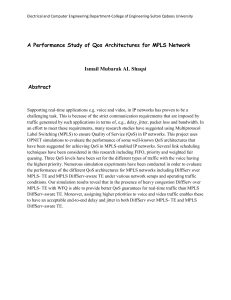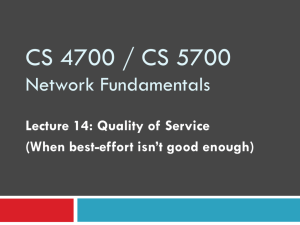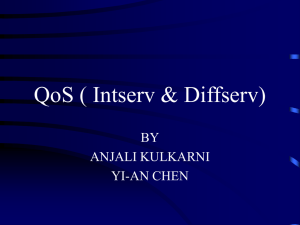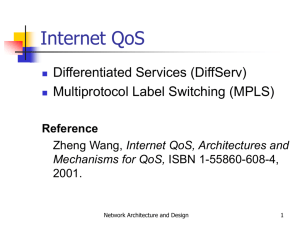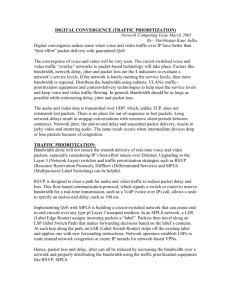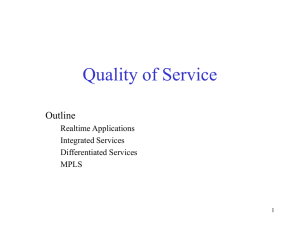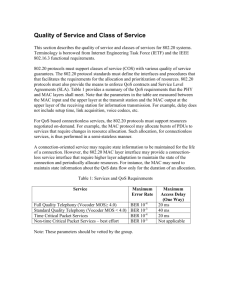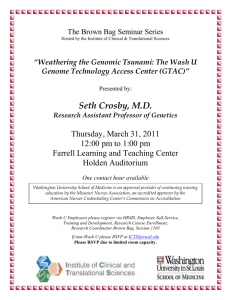유진영
advertisement
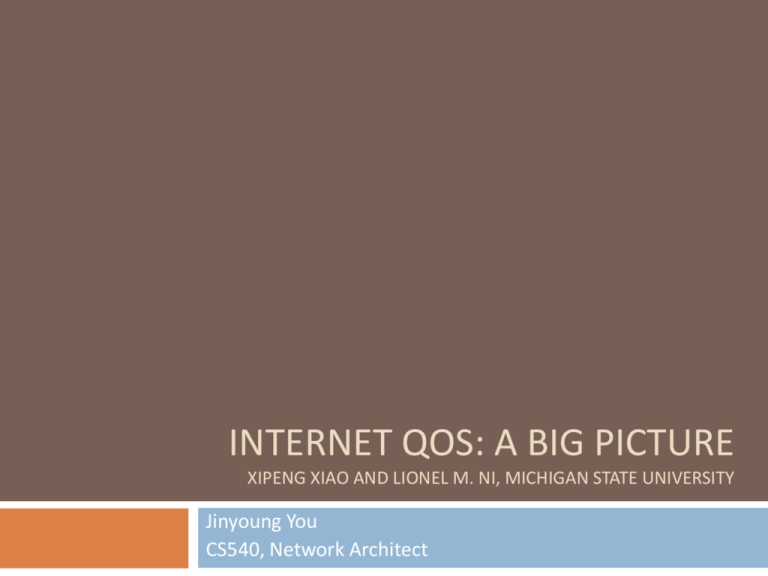
INTERNET QOS: A BIG PICTURE
XIPENG XIAO AND LIONEL M. NI, MICHIGAN STATE UNIVERSITY
Jinyoung You
CS540, Network Architect
Motivation
2
Today’s Internet
Best-effort
service
No guarantee as to timeliness or actual delivery
No guarantee of low-delay and low-jitter services
No service classes
No abundant and cheap bandwidth
Motivation
3
What’s the QoS?
Guarantee
a certain level of performance
e.g.)
Packet dropping probability , Delay, Jitter, Out-oforder delivery, Error, Congestion
Why QoS?
The
network capacity is insufficient
Real-time streaming
e.g.)
multimedia applications
VoIP, IPTV
Requires fixed bit rate and are delay sensitive
Motivation
4
Misunderstanding of QoS
Cannot
provide nonexistent bandwidth
Cannot make the network faster
Cannot cure poorly performing network
Contribution of QoS
Provide
relative prioritization of traffic
Motivation
5
Service Models and Mechanisms of IETF
Integrated
Services/Resource Reservation Protocol
(RSVP) Model
Differentiated Services (DS) model
Multi Protocol Label Switching (MPLS)
Traffic engineering
Constrained Based Protocol
How they differ from and relate to each other?
Which system they fit?
Outline
6
1.
2.
3.
4.
5.
6.
7.
IntServ/RSVP
DiffServ
MPLS
Traffic Engineering/CBR
Comparison of ATM Networks
Conclusion
Q&A
IntServ/RSVP
7
Resource reservation
For
real-time service, before data are transmitted,
Apps must first set up paths and reserve resources
Service classes
Guaranteed service:
fixed delay bound
Controlled-load service: reliable and enhanced best-ef
fort service
IntServ/RSVP
8
IntServ/RSVP
9
Components
Signaling
protocol
Admission control routine
Classifier
Packet scheduler
IntServ/RSVP
10
Limitations
Scalability
State
information is proportional to amount of flow
Overhead
on routers
Should
have all components; RSVP, admission control, MF c
lassification, packet scheduling
Ubiquitous
deployment is required
DiffServ
11
Motivation
DS is essentially a relative-priority scheme
The difficulty in implementing and deploying IntServ and R
SVP
Using DS fields of packet header to indicate service classes
Process complexity
core network → edge network
More scalable
DiffServ
12
Customer
Have a Service Level Agreement (SLA) with its ISP
Mark the DS field according to the service class
Router
Which service class to provide?
Classification, policing, shaping, scheduling occur at only in
gress routers
Domain
DF field is remarked by SLA between the domains
DiffServ
13
Possible services of DiffServ
Premium service
Assured service
For better reliability than best-effort service
Olympic service
For low-delay and low-jitter service
gold, silver, and bronze, with decreasing quality
Differences between DiffServ and IntServ
State information is proportional to the number of classes
Process complexity is only at the edge router
DiffServ
14
Assured Service
Provide
reliable services even in times of network con
gestion
Be
implemented as follows:
Classification
and policing are done at the ingress routers
All packets, in and out, are put into an AQ
The queue is managed by a RED or RIO
DiffServ
15
Premium Service
SLA
specifies a peak bit-rate
Provide low delay and low jitter
e.g.)
More
Be
Internet Telephony, Video Conferencing, VPN
expensive, But more prior than Assured Service
implemented as follows:
Use
P-bit on DS field
If P-bit is on, the packet goes to Premium Queue
Uneven distribution of traffic may cause a problem
DiffServ
16
Service Allocation in Customer Domains
How
to decide services; Assured or Premium Service
Each
host makes its own decision
Bandwidth Broker(BB) makes decision
Resource Allocations in ISP Domains
How
boundary routers handle incoming traffic
Static
SLAs, Manually configured.
Dynamic SLA, RSVP
DiffServ
17
DiffServ
18
DiffServ
Requirements on Routers
Edge
router: MF classifications, marking, and shaping
ISP ingress router: policing, re-marking
ISP egress routers: re-shaping
BA classification, Assured Queue, Premium Queue
For dynamic SLA, BB at the customer domain
MPLS
MPLS: Multi Protocol Label Switching
Incoming packets are assigned a “label” by edge router
Packets are routed according to the label
By a label switch router(LSR)
The path a packet traverses is called label switched
path(LSP)
Network protocol independent
MPLS
MPLS
MPLS is strategically significant
Provides
faster packet classification and forwarding
Provides an efficient tunneling mechanism
without
Moves
Core
encryption
processing to edge routers
did forwarding only, Scalable
Traffic Engineering/CBR
Motivation
IntServ/RSVP
and DiffServ has degradation of
performance when traffic load is heavy.
Major goal
Provide
efficient and reliable network operation
Optimize network resource utilization
To efficiently manage
Optimize
bandwidth resources
traffic performance
To enhance
QoS of traffic stream
Traffic Engineering/CBR
The factor of Congestion
Lack
of network resource
Upgrade
Uneven
infrastructure
distribution
Because
of Shortest Path problem
Constraint Based Routing
Automatically Traffic Engineering
Traffic Engineering/CBR
Shortest Path Problem
Traffic Engineering/CBR
Constrained Based Routing
Compute
QoS route
May
select longest lightly-loaded path rather than heavily
shortest path
Improve
network resource utilization
Traffic Engineering/CBR
Distribution of Link State Information
Needs of link available bandwidth, buffer space information
Link state advertisement of OSPF, IS-IS
Route Computation
Various algorithm for distinct metrics; cost, hop-count,
bandwidth, reliability, delay, jitter
Let d(i, j) be a metric for link (i, j). For any path P = (i, j, k, …,l, m),
metric d is:
Additive if d(P) = d(i, j) + d(j, k) + … + d(l, m)
e.g.) delay, jitter, cost and hop-count
Multiplicative if d(P) = d(i, j) * d(j, k) * … * d(l, m)
e.g.) reliability (1-loss rate)
Concave if d(P) = min{d(i, j), d(j, k), …, d(l, m)}
e.g.) bandwidth
Traffic Engineering/CBR
Pros
Meeting
the needs for QoS requirement of flows
Improved network utilization
Cons
Increased communication
and computation overhead
Increased routing table size
Longer path may consume more resources
Potential routing instability
Traffic Engineering/CBR
The Position of CBR
DiffServ:
Not for replacing, but helping DiffServ
RSVP: Independent with RSVP
CBR
just determines the path of RSVP messages
MPLS
MPLS: forwarding scheme,
CBR: routing scheme
Work together for traffic engineering
Comparison of ATM Networks
ATM Network
Use Virtual Circuit Switching
Pros
Fast
Provide QoS
Cons
ATM cell header overhead
Switch can not work at the boundary of network
ATM Network with DiffServ or MPLS
Provide QoS on the router network
Reduce ATM cell header overhead
Conclusion
QoS is hotly debated issue
Fibers and WDM will make bandwidth so abundant and
cheap
However, New application will be invented to consume it
QoS will be automatically delivered
Thus, Mechanism will be needed to provide QoS
Many mechanisms are provided but they not solve
QoS problem
There is little hope for success
But, Way to go
Q&A
